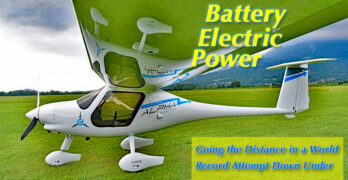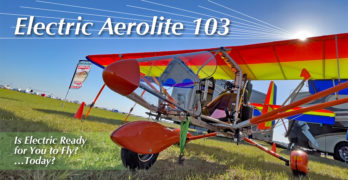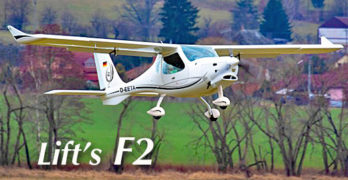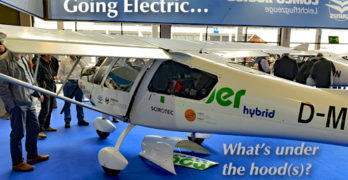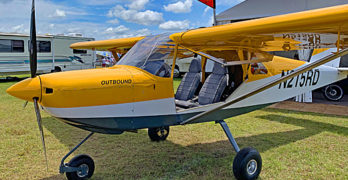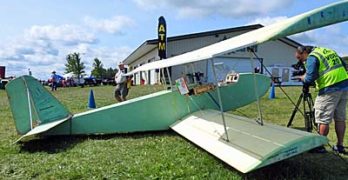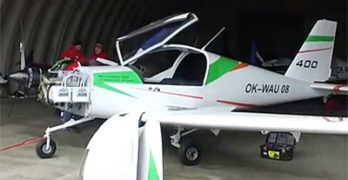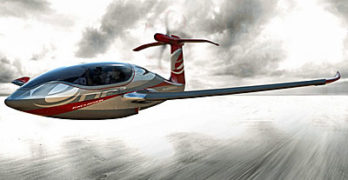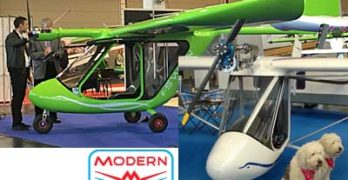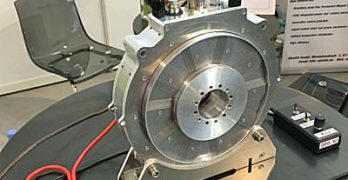Does Alpha have the tiny little motor that could?
Article updated 6/22/21 —DJ
That sounds like an old childhood story (“The Little Engine that Could…”) but here we are in the new millennia with electric cars, huge wind farms, vast solar collector projects, biofuels, and more. Subsidies are pouring in to electric projects around the globe. Hundreds of developers building “urban air transport” multicopters are raising millions of dollars.
Will human-flown conventional aircraft join the electric parade? One company has pursued the electric dream further than most.
This story is about a group in Australia that aimed to set a new world record, one of a rather different sort.
In this case the team plans a “record attempt flying a Pipistrel Alpha Electro plane,” Australia and USA Pipistrel dealer Michael Coates wrote. “[The flight] will start at Parafield Airport at 7:00 a.m. on Saturday June 19, 2021.” Total distance, Michael added, will be 1,150 kilometers, which “will shatter the previous record of 750 kilometers flown in September 2020 in Germany.”
This project hopes to break the previous distance by more than 50 percent.
Search Results for : Electric
Not finding exactly what you expected? Try our advanced search option.
Select a manufacturer to go straight to all our content about that manufacturer.
Select an aircraft model to go straight to all our content about that model.
Sun ‘n Fun 2021 / Day 1 — Charged with Excitement …Battery Electric Aerolite 103 Is Flying Now!
For years I’ve said that of all aircraft to succeed with battery electric flight, the first truly usable, enjoyable aircraft would be a Part 103 ultralight. I’ll list several reasons below but the aircraft you see in these images is already flying with electric propulsion and you can get on the list now.
U-Fly-It boss Dennis Carley said they are working on a name. For now, I’ll call the new entry the Electric Aerolite 103 and this machine is ready for market. A few customers already offered payments to get in line (more on that below, too) and one man wrote a check for an Electric Aerolite even while he keeps flying his gasoline-powered Aerolite. How’s that for a vendor’s dream?
Are you ready for electric? It’s ready for you!
“Clean and Tidy”
You hear that phrase about Aerolite fairly often. A very knowledgeable veteran of the light aircraft business, Scott Severen, spoke of visiting U-Fly-It, producer of the Aerolite.
Charging Back into the Lead — Flight Design ga’s F2 and F2e Light-Sport Aircraft (Gasoline or Electric)
Once upon a time in the then-new world of Light-Sport Aircraft Flight Design lead the pack for airplanes delivered and registered. That #1 ranking lasted for a decade.
Then came a pause in the juggernaut that is Flight Design, a German company with a popular design. The company’s expenses outran their revenues and a major restructuring was forced upon them by the German legal system. This was 2015 but at Aero Friedrichshafen 2019, the company was looking strong. Their prominent space in Aero’s huge gymnasium-sized exhibit halls was filled with interesting machines, including the distinctive Horten flying wing.
All these today operate under the parent name, Lift, which also acquired the Rotorvox deluxe gyroplane.
Attracting a lot of attention was their brand-new F-series. Displayed as the first aircraft visitors saw, F2 is an evolved version of the company’s successful CT-series, which remains in active manufacturing.
Aero Friedrichshafen Day 3: ELECTRIC, Hybrid on Tecnam and Comco – Battery on Horten and Bristell
More from Aero as Day 3 closes. Because of the number on display — and because several readers asked — this post will focus on electric propulsion in two distinct forms. Whatever you think about electric as a means of lifting aircraft aloft, escaping its approach appears impossible. Experimentation is happening in all quarters. The following review is far from exhaustive; many other examples could be found at Aero Friedrichshafen 2019.
Most agree that batteries are the weak link in the chain and despite repeated promises of annual increases in energy density of 5-8%, it hasn’t happened over ten years I’ve followed this fairly closely. That does not preclude certain effective uses, for example, local area primary flight training or aerobatic flying. Yet flying cross country on batteries remains somewhere in the future. Nonetheless, projects abound and solutions may be upon us. Here’s what I saw today.
Hybrid Power from Tecnam, Rotax, and Siemens — I had no choice but to drop big names because these three powerhouses are joining forces on a hybrid system.
Sun ‘n Fun Day 4 — Rans Outbound Tricycle, Amphibious Trikes, Electric Powered Paraglider
Sun ‘n Fun streaks on with Blue Angels and Stearmans cracking the air. Exhibits are active. People are shopping for the right airplane. Strong crowds were present at peak times. Opening day may have set a record. Generally vendors and customers seemed to be in good spirits. Recreational aviation looks healthy.
As I spoke with vendors, one comment I heard repeatedly — freely offered but never requested — was “The economy is good. People have money to spend.” This statement came up often enough to give it weight.
Those of you shopping at home can have a little fun with PlaneFinder 2.0. Clicking or tapping a few categories will help you zero in on the best choices for you. Then you can click to articles or videos about them.
Outbound — Rans has enjoyed quite a run with their newest, the S-21 Outbound. It is a handsome taildragger with performance to make STOL designs jealous.
Twin-Electric-Motor Biplane Made Mostly from Foam …and, Yes, a Human Flies It!
For your enjoyment, here is arguably the most unique airplane I found on the grounds of EAA AirVenture Oshkosh 2018 …and with around 3,000 show planes, that is truly saying something.
This aircraft is made almost entirely of foam sheets that you can buy at Home Depot or Lowe’s. It uses two electric motors for thrust. The aircraft is a biplane taildragger. Batteries provide the fuel.
Plus, yes, it actually flies! Catch some of the action in two videos below.
Award Winner?
This unusual arrangement was prepared for EAA’s tough judges. However it fared in that evaluation, this clearly wins an award in my mind for being highly original, unique, super affordable, and OK… it is rather delightfully weird, not that that I see anything wrong with that.
What you are seeing in the nearby photos and videos below is Peter Sripol‘s man-carrying scratch-built aircraft project.
Peter is a longtime modeler and homebuilder with a popular YouTube channel that boasts more than 650,000 subscribers!
Electric Experimentation Grows; LSA and Ultralights Will Succeed First
As the world appears to shift into overdrive about electric cars, planes, and drones, what is happening in this dynamic, unfolding sector in aviation?
Recent news from Pipistrel spoke to their continued development of their Alpha Electro. This Slovenian company has long pursued this and may be leading in commercialization but — as with electric autos — this remains a minuscule part of total sales. However, it attracts outsized attention from mainstream media, regulators, and others.
Recently, my friend and LAMA Europe associate, Jan Friedrich, alerted me to a new success story.
The Skyleader company is somewhat known in the USA although perhaps by their earlier name Kappa. The more correct name was and is Jihlavan Airplanes but Skyleader is a better marketing name.
Americans have seen examples of the company’s top-of-the-line Skyleader 600 — here’s our video review of the model — but sales have not taken off in this country.
Sleek, Sexy Electric Light-Sport Seaplane
AirMax SeaMax — Icon A5 — Vickers Wave — MVP — Lisa Akoya… you only need look at the best promoted brands to see that arguably the most innovative ideas in light aircraft are coming from the LSA seaplane sector. Each of these is a great example of visionary engineering.
Others LSA or light kit seaplane developments — Searey, Mermaid, ATOL Avion, Aero Adventure, among others — are somewhat more conventional but that’s reassuring to some potential buyers. All these names have one enormous advantage. They have practical field experience. Of the five in the first paragraph, only SeaMax has a longer period of use by owners in regular operation.
Now consider Equator Aircraft P2 Xcursion, an electric hybrid seaplane with several compelling ideas. I wrote about this in an article two years ago; now we have an update.
Swan Ultralight Goes Both Ways: Electric & Gas
In my views of Swan at previous Aero Friedrichshafen shows, the design caught my eye as it was (a) a single seater, (b) light enough to qualify as a Part 103 ultralight or its European equivalents, and (c) as it was an all-composite, nicely designed aircraft. Commonly, Part 103-capable designs are much more basic to remain within the tight limits. This statement also applies to the German 120-kilogram category or to Britain’s Single Seat DeRegulated (SSDR) description.
As Aero contributor and Powered Sport Flying publisher Roy Beisswenger and I frequently discuss, the most likely place for electric propulsion to work today is in ultralights. This is because in very light aircraft with more local flying missions, battery weights for a modest period of flying (30-60 minutes) is already achievable in the very lightest of powered aircraft. We have been discussing this with FAA for more than three years.
Electric Propulsion Innovations at Aero 2017
Electric aircraft may still have minuscule market share but innovations could change that in the near future. As Aero correspondent, Roy Beisswenger wrote, “This is a rapidly changing technology with both motors and applications showing up all over Aero Friedrichshafen.” This year Aero management concentrated them in one of the big halls where small startups to the heavyweights were located. Thanks to Roy for several reports from Aero, of which this is one. —DJ
Many of the exhibited motors are for very light applications such as light-weight shift control trikes or gliders but motors are becoming more powerful. With an increase in power, new technical problems need to become overcome. For example, the larger the power capability of the motor, the more cooling is required for the motor. Smaller motors are mostly air-cooled, but some of the medium and larger motors require liquid cooling. This doesn’t mean that the motors have radiators, but liquid is built into the motor to help wick heat away from hot spots that are created when electricity is converted to mechanical power.
- « Previous Page
- 1
- 2
- 3
- 4
- …
- 67
- Next Page »


